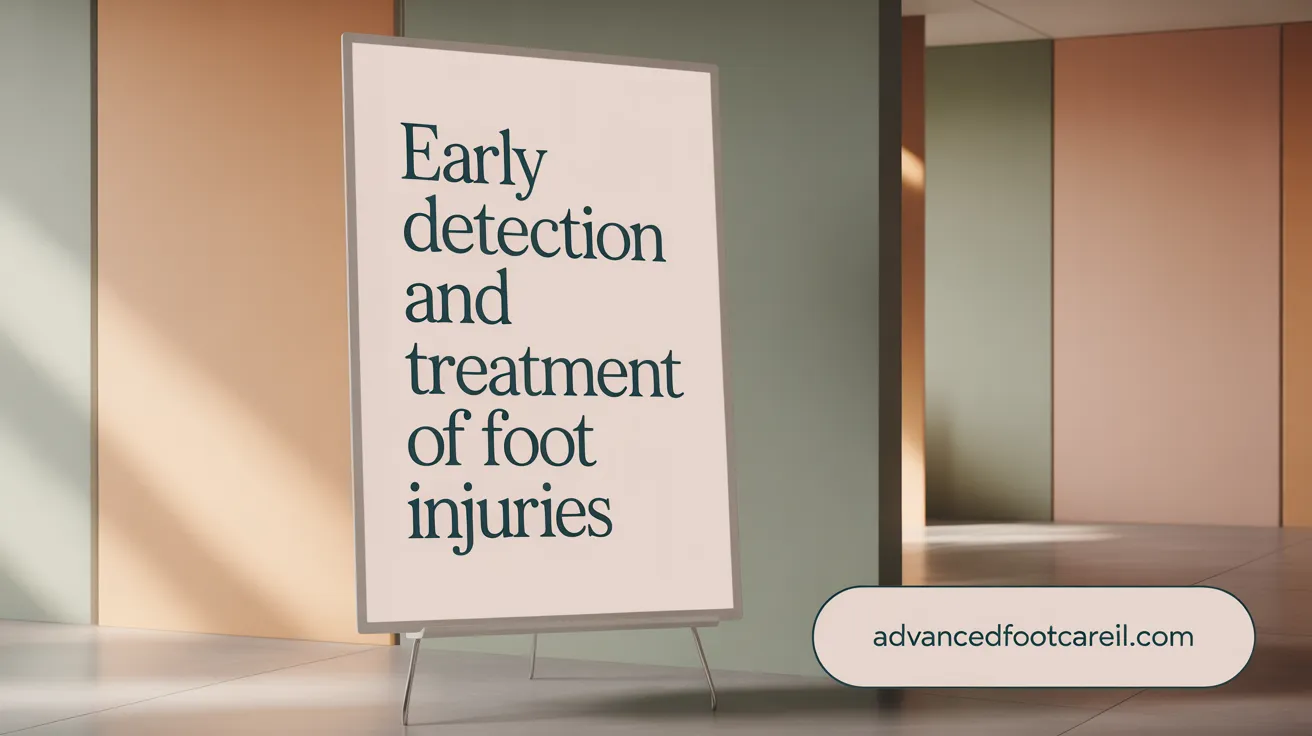Why Foot Care is Crucial for Athletes
Importance of Foot Health for Athletic Performance
Healthy feet are fundamental for athletes to maintain efficiency and excel in their sport. Proper foot function ensures balance, stability, and optimal movement mechanics, which can enhance athletic performance and reduce fatigue during activity.
Common Impact of Foot Injuries on Athletes
Foot and ankle injuries are among the most frequent in sports, accounting for roughly 25% of injuries. Conditions such as plantar fasciitis, Achilles tendinitis, ankle sprains, and stress fractures commonly disrupt training and competition. These injuries often lead to pain, swelling, limited mobility, and prolonged recovery time, impairing an athlete's ability to perform at their best.
Role of Preventive Care in Sports Medicine
Preventive foot care is vital to minimize injury risks. This includes wearing sport-specific, well-fitting footwear that supports foot structure, implementing appropriate warm-up and stretching routines, and undertaking strengthening exercises to improve foot stability. Regular assessments by podiatrists can identify biomechanical imbalances and guide the use of orthotics or braces, which help prevent injury recurrence. Early recognition of symptoms and prompt management also reduce downtime and long-term complications.
Footwear Selection and Maintenance: The Foundation of Injury Prevention

Choosing Sport-Specific Shoes for Proper Support
Selecting footwear that matches the specific demands of your sport is essential to prevent foot and ankle injuries. Different sports place unique stresses on the feet, requiring shoes designed for those forces. For example, running shoes prioritize cushioning and shock absorption, while basketball shoes offer lateral support to handle quick side-to-side movements.
Importance of Shoes Matching Foot Type
Proper shoe fit goes beyond size; considering your foot type improves comfort and reduces injury risk. Shoes that support your arch—whether low, normal, or high—help maintain proper foot mechanics and prevent problems such as overpronation or supination. Customized orthotics can further enhance support by correcting biomechanical imbalances.
When and Why to Replace Athletic Shoes
Replacing worn-out shoes regularly is crucial for sustained injury prevention. Athletic shoes generally last about six months or between 300 to 500 miles of use. Signs you need new shoes include worn treads, reduced cushioning, and changes in foot alignment or discomfort during activity. Continuing to use old or damaged footwear increases the risk of conditions like plantar fasciitis, stress fractures, and Achilles tendinitis.
Role of Orthotics in Injury Prevention
Orthotics, whether custom-made or off-the-shelf, provide additional support tailored to individual foot needs. They aid in correcting alignment, distributing pressure more evenly, and stabilizing the foot during dynamic movements. Incorporating orthotics with proper footwear can lower the incidence of overuse injuries and enhance overall foot function (source).
Maintaining optimal footwear through informed selection and timely replacement, complemented by orthotic support, forms a fundamental part of comprehensive foot injury prevention strategies for athletes and active individuals alike.
Pre-Activity and Recovery Routines to Enhance Foot Health

Warming Up with Stretching and Light Jogging
Properly Warming Up Before Sports before physical activity is essential to prepare the muscles, tendons, and joints of the feet and ankles for exercise. Light jogging combined with Stretching Exercises for Foot Injury Prevention , such as toe presses, ankle circles, and Achilles tendon stretches, increases flexibility and blood flow. This preparation reduces the risk of sprains, tendonitis, and other injuries by ensuring that the foot structures are ready to handle stress.
Dynamic Warm-Ups and Specific Foot Exercises
Dynamic warm-ups involving movements like single-leg balance drills, heel raises, and toe curls not only improve flexibility but also enhance foot stability. These foot-specific exercises Foot Care Tips Every Athlete Should Know , helping athletes maintain balance and prevent falls or ankle sprains during dynamic sports activities.
Post-Activity Recovery Methods Including Icing and Massage
After exercise, recovery routines play a crucial role in preventing injuries and supporting tissue repair. Applying cold therapy or Podiatric Sports Recovery Routines helps reduce inflammation and soothe sore muscles. Heat therapy can promote blood flow, while techniques such as self-massage with a tennis ball or frozen water bottle relieve tension in the plantar fascia and calf muscles. Stretching to maintain foot and calf flexibility post-activity also aids in preventing stiffness and chronic conditions like plantar fasciitis.
Importance of Gradual Increase in Activity Intensity
To minimize Preventing Foot Injuries in Athletes such as stress fractures or Achilles tendonitis, it is vital to increase training intensity and duration gradually. Following recommended guidelines, like the '10% rule'—increasing activity by no more than 10% per week—allows the feet time to adapt safely to new demands, reducing injury risk in both casual and serious athletes.
Strengthening, Balance, and Hygiene Practices to Reduce Risk

Foot and Ankle Strengthening Exercises
To reduce the risk of foot and ankle injuries, incorporating targeted strengthening exercises is essential. Simple movements such as toe raises, heel raises, and toe curls can significantly enhance muscle strength and flexibility in the feet. These exercises support the ligaments and tendons, helping to absorb impact and maintain proper alignment during athletic activities.
Balance Drills to Improve Stability
Balance exercises play a crucial role in preventing injuries by improving foot and ankle stability. Activities like single-leg stands, ankle circles, and dynamic drills that challenge proprioception enhance joint control. Improved stability helps athletes better manage uneven surfaces and sudden movements, lowering the risk of sprains and strains. For more on balance exercises to prevent injuries, see this resource.
Daily Foot Hygiene to Prevent Infections
Maintaining good foot hygiene is another important preventive measure. Washing feet daily with thorough drying, especially between the toes, prevents fungal infections like athlete’s foot. Wearing moisture-wicking socks and well-fitting shoes further reduces moisture buildup and bacterial growth, promoting overall foot health.
Signs to Monitor for Early Injury Detection
Athletes should be vigilant for early signs of foot problems including persistent pain, swelling, redness, or numbness. Early detection allows prompt intervention, preventing minor issues like inflammation or minor sprains from escalating into chronic conditions. Regular foot inspections, especially after intensive activity, help catch problems early. For guidance on when to seek medical attention for foot pain, refer here.
Together, these practices—strengthening exercises, balance drills, meticulous hygiene, and early symptom monitoring—form an effective strategy to enhance athletic performance and reduce foot and ankle injury risks. For a comprehensive overview on preventing foot and ankle injuries, consult this resource.
Recognizing and Managing Common Sports-Related Foot Injuries Early

What Are Common Sports-Related Foot Injuries?
Athletes frequently encounter foot injuries such as plantar fasciitis, Achilles tendonitis, stress fractures, and turf toe. Plantar fasciitis involves inflammation of the connective tissue on the sole, leading to heel pain, particularly after prolonged standing or activity. Achilles tendonitis results from overuse causing irritation and swelling at the back of the heel. Stress fractures are tiny bone cracks caused by repetitive high-impact activity, often affecting foot and shin bones. Turf toe is a sprain of the big toe joint from hyperextension, frequently seen in sports played on artificial turf.
Why Is Early Recognition of Symptoms Critical?
Promptly identifying symptoms such as pain, swelling, tenderness, or limited mobility is essential. Early recognition prevents worsening of the injury and reduces the risk of chronic complications. Symptoms like aching, burning sensations, or difficulty bearing weight should not be ignored, especially in athletes increasing training intensity or returning from a break (Recognizing Early Symptoms of Foot Injuries).
What Are Immediate Treatments for These Injuries?
The RICE method—Rest, Ice, Compression, and Elevation—is effective immediately after injury onset to reduce swelling and pain. Resting the affected foot prevents further damage, while icing controls inflammation. Compression with bandages supports injured tissues, and elevation decreases swelling by improving venous return.
When Should Athletes Seek Professional Podiatric Care?
If pain persists despite initial care, or there is noticeable swelling, bruising, or difficulty walking, consulting a podiatrist is strongly advised. Professional evaluation can confirm the diagnosis through clinical exams and imaging and guide individualized treatment plans. Early medical intervention can include physical therapy, orthotics, or medication, improving recovery outcomes and reducing risk for chronic injury or surgery (Foot doctor evaluation for athletes).
The Role of the Podiatrist in Long-Term Injury Prevention and Care
How Does Gait and Foot Mechanics Assessment Aid Injury Prevention?
A podiatrist begins long-term injury prevention by thoroughly evaluating an athlete's gait and foot mechanics. This assessment helps identify abnormalities in walking or running patterns that might increase injury risk. By analyzing stride length, foot placement, and balance, podiatrists can pinpoint biomechanical inefficiencies that lead to stress on the feet and ankles.
What Role Do Custom Orthotics and Personalized Prevention Plans Play?
Custom orthotics are tailored inserts designed to correct biomechanical imbalances such as overpronation or high arches. When prescribed by a podiatrist, they provide targeted support, relieving undue pressure and optimizing foot alignment during movement. Complementing orthotics, personalized prevention plans incorporate individualized strategies including footwear recommendations, activity modifications, and strengthening routines to reduce injury recurrence effectively (custom orthotics for injury prevention).
How Are Rehabilitation and Strengthening Managed Post-Injury?
Post-injury rehabilitation guided by a podiatrist focuses on restoring foot and ankle stability, flexibility, and muscle strength. Rehabilitation programs include exercises like heel raises, toe curls, and balance drills that rebuild coordination and ligament resilience. This systematic approach supports safe return to activity and minimizes risks of chronic issues or repeated injuries (rehabilitation and strengthening programs.
When Is Minimally Invasive Foot and Ankle Surgery Beneficial?
In cases where conservative treatments are insufficient, minimally invasive foot and ankle surgery offers a precise and less traumatic alternative to traditional surgery. Procedures, such as anatomical lateral ligament reconstruction, use small incisions to correct deformities or instability with quicker recovery times and minimal scarring. This surgical option benefits athletes by preserving mobility, allowing earlier return to sport, and reducing long-term complications.
By integrating these approaches, podiatrists provide comprehensive care that not only treats existing injuries but also proactively prevents future problems, ensuring optimal foot health and athletic performance (Role of a podiatrist in sports medicine).
Commit to Proactive Foot Care for Athletic Longevity
Key Preventive Measures for Healthy Feet in Athletics
Athletes can greatly reduce the risk of foot and ankle injuries by incorporating effective preventive strategies. Proper footwear tailored to the sport, regular replacement of worn-out shoes, and the use of custom orthotics support proper biomechanics. Equally important are warm-up routines including stretching exercises for the calves, Achilles tendon, and feet, alongside balance and strengthening drills such as toe curls and heel raises. Gradual intensity progression and attentive rest periods also help avoid overuse injuries like stress fractures and plantar fasciitis.
The Role of Professional Guidance
Regular consultations with podiatrists are indispensable for athletes. Professional evaluations encompass gait analysis, foot structure assessment, and injury risk identification. Podiatrists provide personalized interventions, including orthotic fittings and rehabilitation plans to restore stability and prevent re-injury. Early diagnosis and management of foot pain or abnormalities can avert chronic complications and support sustained athletic performance.
Prioritize Foot Health for Long-Term Athletic Success
Athletes should view foot health as a cornerstone of their overall fitness and longevity. Attentive self-care—such as daily hygiene, monitoring symptoms, and seeking timely medical advice—combined with professional support enables athletes to maintain peak foot function. By committing to these proactive practices, athletes can enhance their resilience, minimize downtime due to injury, and confidently pursue their sports goals over the long term.
